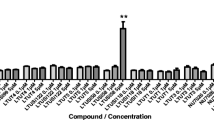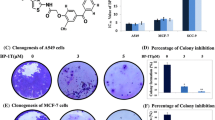Summary
Targeting tumor vasculature represents a rational strategy for controlling cancer. (Z)-(+/−)-2-(1-benzylindol-3-ylmethylene)-1-azabicyclo[2.2.2]octan-3-ol (denoted VJ115) is a novel chemical entity that inhibits the enzyme ENOX1, a NADH oxidase. Genetic and small molecule inhibition of ENOX1 inhibits endothelial cell tubule formation and tumor-mediated neo-angiogenesis. Inhibition of ENOX1 radiosensitizes tumor vasculature, a consequence of enhanced apoptosis. However, the molecular mechanisms underlying these observations are not well understood. Herein, we mechanistically link ENOX1-mediated regulation of cellular NADH concentrations with proteomics profiling of endothelial cell protein expression following exposure to VJ115. Pathway Studios network analysis of potential effector molecules identified by the proteomics profiling indicated that a VJ115 exposure capable of altering intracellular NADH concentrations impacted proteins involved in cytoskeletal reorganization. The analysis was validated using RT-PCR and immunoblotting of selected proteins. RNAi knockdown of ENOX1 was shown to suppress expression of stathmin and lamin A/C, proteins identified by the proteomics analysis to be suppressed upon VJ115 exposure. These data support the hypothesis that VJ115 inhibition of ENOX1 can impact expression of proteins involved in cytoskeletal reorganization and support a hypothesis in which ENOX1 activity links elevated cellular NADH concentrations with cytoskeletal reorganization and angiogenesis.






Similar content being viewed by others
References
Folkman J (1971) Tumor angiogenesis: therapeutic implications. N Engl J Med 285:1182–1186
Goel S, Duda DG, Xu L, Munn LL, Boucher Y, Fukumura D et al (2011) Normalization of the vasculature for treatment of cancer and other diseases. Physiol Rev 91:1071–1121
Sitohy B, Nagy JA, Dvorak HF (2012) Anti-VEGF/VEGFR therapy for cancer: reassessing the target. Cancer Res 72:1909–1914
Jiang Z, Gorenstein NM, Morre DM, Morre DJ (2008) Molecular cloning and characterization of a candidate human growth-related and time-keeping constitutive cell surface hydroquinone (NADH) oxidase. Biochemistry 47:14028–14038
Geng L, Rachakonda G, Morre DJ, Morre DM, Crooks PA, Sonar VN et al (2009) Indolyl-quinuclidinols inhibit ENOX activity and endothelial cell morphogenesis while enhancing radiation-mediated control of tumor vasculature. FASEB J 23:2986–2995
Venkateswaran A SK, Melville DB, Levic DS, Rybski WM, Walsh AJ, Skala MC, Crooks PA, Freeman ML, Knapik EW. The NADH oxidase Enox1 is required for vasculogenesis in Zebrafish. In Preparation.
Miyashita H, Kanemura M, Yamazaki T, Abe M, Sato Y (2004) Vascular endothelial zinc finger 1 is involved in the regulation of angiogenesis: possible contribution of stathmin/OP18 as a downstream target gene. Arterioscler Thromb Vasc Biol 24:878–884
Lee JS, Hale CM, Panorchan P, Khatau SB, George JP, Tseng Y et al (2007) Nuclear lamin A/C deficiency induces defects in cell mechanics, polarization, and migration. Biophys J 93:2542–2552
Skala MC, Riching KM, Gendron-Fitzpatrick A, Eickhoff J, Eliceiri KW, White JG et al (2007) In vivo multiphoton microscopy of NADH and FAD redox states, fluorescence lifetimes, and cellular morphology in precancerous epithelia. Proc Natl Acad Sci U S A 104:19494–19499
Alban A, David SO, Bjorkesten L, Andersson C, Sloge E, Lewis S et al (2003) A novel experimental design for comparative two-dimensional gel analysis: two-dimensional difference gel electrophoresis incorporating a pooled internal standard. Proteomics 3:36–44
Wessel D, Flugge UI (1984) A method for the quantitative recovery of protein in dilute solution in the presence of detergents and lipids. Anal Biochem 138:141–143
Zhang B, Chambers MC, Tabb DL (2007) Proteomic parsimony through bipartite graph analysis improves accuracy and transparency. J Proteome Res 6:3549–3557
Klaidman LK, Leung AC, Adams JD Jr (1995) High-performance liquid chromatography analysis of oxidized and reduced pyridine dinucleotides in specific brain regions. Anal Biochem 228:312–317
Avi-Dor Y, Olson JM, Doherty MD, Kaplan NO (1962) Fluorescence of pyridine nucleotides in mitochondria. J Biol Chem 237:2377–2383
Andersen JN, Sathyanarayanan S, Di Bacco A, Chi A, Zhang T, Chen AH et al (2010) Pathway-based identification of biomarkers for targeted therapeutics: personalized oncology with PI3K pathway inhibitors. Sci Transl Med 2:43ra55
Chen HX (2004) Expanding the clinical development of bevacizumab. Oncologist 9(Suppl 1):27–35
Kozin SV, Boucher Y, Hicklin DJ, Bohlen P, Jain RK, Suit HD (2001) Vascular endothelial growth factor receptor-2-blocking antibody potentiates radiation-induced long-term control of human tumor xenografts. Cancer Res 61:39–44
Wachsberger P, Burd R, Dicker AP (2003) Tumor response to ionizing radiation combined with antiangiogenesis or vascular targeting agents: exploring mechanisms of interaction. Clin Cancer Res 9:1957–1971
Willett CG, Boucher Y, di Tomaso E, Duda DG, Munn LL, Tong RT et al (2004) Direct evidence that the VEGF-specific antibody bevacizumab has antivascular effects in human rectal cancer. Nat Med 10:145–147
Winkler F, Kozin SV, Tong RT, Chae SS, Booth MF, Garkavtsev I et al (2004) Kinetics of vascular normalization by VEGFR2 blockade governs brain tumor response to radiation: role of oxygenation, angiopoietin-1, and matrix metalloproteinases. Cancer Cell 6:553–563
Yoon SS, Duda DG, Karl DL, Kim TM, Kambadakone AR, Chen YL et al (2011) Phase II study of neoadjuvant bevacizumab and radiotherapy for resectable soft tissue sarcomas. Int J Radiat Oncol Biol Phys 81:1081–1090
Amodio G, Moltedo O, Monteleone F, D’Ambrosio C, Scaloni A, Remondelli P et al (2010) Proteomic signatures in thapsigargin-treated hepatoma cells. Chem Res Toxicol 24:1215–1222
Kellokumpu S, Sormunen R, Heikkinen J, Myllyla R (1994) Lysyl hydroxylase, a collagen processing enzyme, exemplifies a novel class of luminally-oriented peripheral membrane proteins in the endoplasmic reticulum. J Biol Chem 269:30524–30529
Rahajeng J, Giridharan SS, Naslavsky N, Caplan S (2010) Collapsin response mediator protein-2 (Crmp2) regulates trafficking by linking endocytic regulatory proteins to dynein motors. J Biol Chem 285:31918–31922
Lee SH, Dominguez R (2010) Regulation of actin cytoskeleton dynamics in cells. Mol Cells 29:311–25.
Eriksson JE, Dechat T, Grin B, Helfand B, Mendez M, Pallari HM et al (2009) Introducing intermediate filaments: from discovery to disease. J Clin Invest 119:1763–1771
Lazarides E (1980) Intermediate filaments as mechanical integrators of cellular space. Nature 283:249–256
Gruenbaum Y, Margalit A, Goldman RD, Shumaker DK, Wilson KL (2005) The nuclear lamina comes of age. Nat Rev Mol Cell Biol 6:21–31
Emerson LJ, Holt MR, Wheeler MA, Wehnert M, Parsons M, Ellis JA (2009) Defects in cell spreading and ERK1/2 activation in fibroblasts with lamin A/C mutations. Biochim Biophys Acta 1792:810–821
Yoshie M, Miyajima E, Kyo S, Tamura K (2009) Stathmin, a microtubule regulatory protein, is associated with hypoxia-inducible factor-1alpha levels in human endometrial and endothelial cells. Endocrinology 150:2413–2418
Guizetti J, Schermelleh L, Mantler J, Maar S, Poser I, Leonhardt H et al (2011) Cortical constriction during abscission involves helices of ESCRT-III-dependent filaments. Science 331:1616–1620
Dai S, Jia Y, Wu SL, Isenberg JS, Ridnour LA, Bandle RW et al (2008) Comprehensive characterization of heat shock protein 27 phosphorylation in human endothelial cells stimulated by the microbial dithiole thiolutin. J Proteome Res 7:4384–4395
Keezer SM, Ivie SE, Krutzsch HC, Tandle A, Libutti SK, Roberts DD (2003) Angiogenesis inhibitors target the endothelial cell cytoskeleton through altered regulation of heat shock protein 27 and cofilin. Cancer Res 63:6405–6412
Muriel O, Echarri A, Hellriegel C, Pavon DM, Beccari L, Del Pozo MA (2011) Phosphorylated filamin A regulates actin-linked caveolae dynamics. J Cell Sci 124:2763–76.
De Luca T, Morre DM, Morre DJ (2010) Reciprocal relationship between cytosolic NADH and ENOX2 inhibition triggers sphingolipid-induced apoptosis in HeLa cells. J Cell Biochem 110:1504–1511
Su Y, Rosenthal D, Smulson M, Spiegel S (1994) Sphingosine 1-phosphate, a novel signaling molecule, stimulates DNA binding activity of AP-1 in quiescent Swiss 3T3 fibroblasts. J Biol Chem 269:16512–16517
Acknowledgements
Supported in part by grants from U.S. National Institutes of Health/National Cancer Institute grants RO1CA140409, T32CA093240, Vanderbilt-Ingram Cancer Center grant P30 CA68485, and the Vanderbilt Academic Venture Capital fund for proteomics. We are thankful to Drs. V.J. Sonar and Y.T.R. Reddy for the synthesis of VJ115.
Conflict of interest statement
The authors declare that they have no conflict of interest
Author information
Authors and Affiliations
Corresponding authors
Electronic supplementary material
Below is the link to the electronic supplementary material.
Supplemental Fig. 1
The relative change in protein expression over time for 20 polypeptides from 2D-DIGE study whose abundance changed by 20 % or more (p < 0.05) after VJ115 treatment. (DOC 86 kb)
Supplemental Fig. 2
A) Western blot analysis was employed to confirm the down-regulation of phosphor-c-Jun expression. B) Immunoblot of phosphorylation status of p70S6K and its down-stream target, ribosomal protein S6 in HUVECs exposed to VJ115. (DOC 70 kb)
Rights and permissions
About this article
Cite this article
Venkateswaran, A., Friedman, D.B., Walsh, A.J. et al. The novel antiangiogenic VJ115 inhibits the NADH oxidase ENOX1 and cytoskeleton-remodeling proteins. Invest New Drugs 31, 535–544 (2013). https://doi.org/10.1007/s10637-012-9884-9
Received:
Accepted:
Published:
Issue Date:
DOI: https://doi.org/10.1007/s10637-012-9884-9




